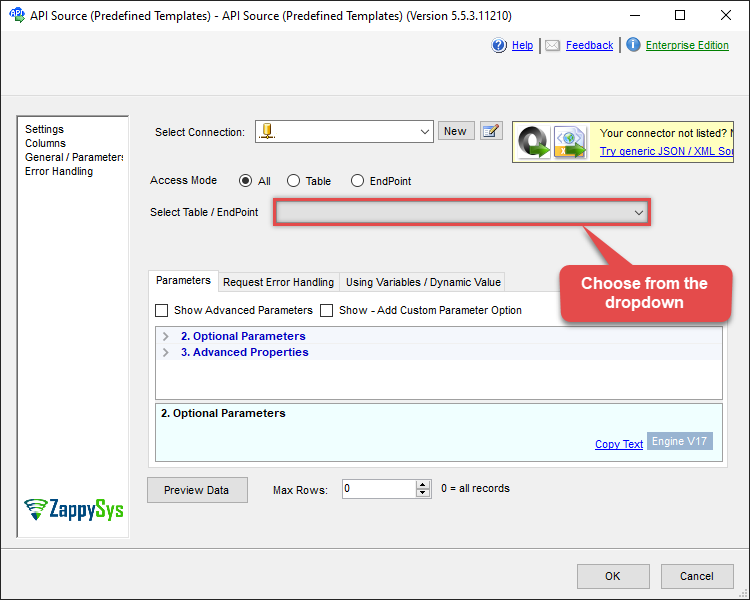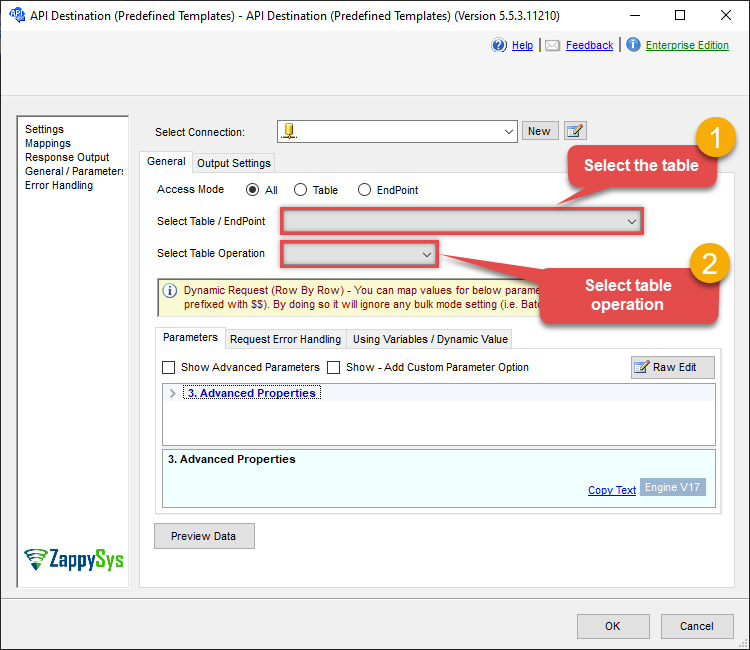Endpoint Read JSON File (Generic)
Name
get_json_file
Description
Related Tables
Parameters
| Parameter | Required | Options | ||||||||||||||||
|---|---|---|---|---|---|---|---|---|---|---|---|---|---|---|---|---|---|---|
|
Name:
Label: Drive Id Specify a drive |
YES | |||||||||||||||||
|
Name:
Label: File Id or Path (e.g. root:/somefolder/myfile.xyz: ) - Max 1000 Listed Specify a File Id or Path. Syntax: [{file-id}] -OR- [root:/{file-path}:] (Example: root:/folder/subfolder/myfile.xyz: ) |
YES | |||||||||||||||||
|
Name:
Label: Site Id (Re-Select Drive Id after you change this) Specify a site |
||||||||||||||||||
|
Name:
Label: Search Type - For UI Only (i.e. Recursive -OR- Non-Recursive) - Default=Recursive) NOTE: Not Supported with Application Credentials which uses Sites.Selected Scope. If you do not wish to see files from child folders then use Non-Recursive option. Recursive option has certain limitations (e.g. Only indexed files will appear so it takes time to show up in the list). If you do not see some files listed in the output then use Non-Recursive option (must specify Parent Folder Path in SearchPath property). |
|
|||||||||||||||||
|
Name:
Label: Search Folder (For UI Only - Helps to narrow down File Selection DropDown) - Max 200 Listed This parameter is only for UI. Select this to narrow down File List Dropdown. Select Search Folder first and then select File List dropdown to see new File list (found under this selected folder). |
Output Columns
| Label | Data Type (SSIS) | Data Type (SQL) | Length | Description | |||||||||||||||||||||||||||||||||||||||||||||||||||||||||||||||||||||||||||||||||||||||||||||||
|---|---|---|---|---|---|---|---|---|---|---|---|---|---|---|---|---|---|---|---|---|---|---|---|---|---|---|---|---|---|---|---|---|---|---|---|---|---|---|---|---|---|---|---|---|---|---|---|---|---|---|---|---|---|---|---|---|---|---|---|---|---|---|---|---|---|---|---|---|---|---|---|---|---|---|---|---|---|---|---|---|---|---|---|---|---|---|---|---|---|---|---|---|---|---|---|---|---|---|---|
| There are no Static columns defined for this endpoint. This endpoint detects columns dynamically at runtime. | |||||||||||||||||||||||||||||||||||||||||||||||||||||||||||||||||||||||||||||||||||||||||||||||||||
Input Columns
| Label | Data Type (SSIS) | Data Type (SQL) | Length | Description | |||||||||||||||||||||||||||||||||||||||||||||||||||||||||||||||||||||||||||||||||||||||||||||||
|---|---|---|---|---|---|---|---|---|---|---|---|---|---|---|---|---|---|---|---|---|---|---|---|---|---|---|---|---|---|---|---|---|---|---|---|---|---|---|---|---|---|---|---|---|---|---|---|---|---|---|---|---|---|---|---|---|---|---|---|---|---|---|---|---|---|---|---|---|---|---|---|---|---|---|---|---|---|---|---|---|---|---|---|---|---|---|---|---|---|---|---|---|---|---|---|---|---|---|---|
| There are no Static columns defined for this endpoint. This endpoint detects columns dynamically at runtime. | |||||||||||||||||||||||||||||||||||||||||||||||||||||||||||||||||||||||||||||||||||||||||||||||||||
Examples
SSIS
Use SharePoint Online Connector in API Source or in API Destination SSIS Data Flow components to read or write data.
API Source
This Endpoint belongs to the JSON File Read/Write table, therefore it is better to use it, instead of accessing the endpoint directly:
| Required Parameters | |
|---|---|
| Drive Id | Fill-in the parameter... |
| File Id or Path (e.g. root:/somefolder/myfile.xyz: ) - Max 1000 Listed | Fill-in the parameter... |
| FileCompressionType | Fill-in the parameter... |
| Optional Parameters | |
| Site Id (Re-Select Drive Id after you change this) | |
| Search Type - For UI Only (i.e. Recursive -OR- Non-Recursive) - Default=Recursive) | |
| Search Folder (For UI Only - Helps to narrow down File Selection DropDown) - Max 200 Listed | |
| DataFormat | Notset |
| Continue On 404 Error (When item not found) | True |
| Filter | |
| ExcludedProperties | |
| Encoding | |
| CharacterSet | |
| EnableCustomReplace | |
| SearchFor | |
| ReplaceWith | |
| EnableArrayFlattening | |
| MaxArrayItemsToFlatten | |
| ArrayTransformType | |
| ArrayTransColumnNameFilter | |
| ArrayTransRowValueFilter | |
| ArrayTransEnableCustomColumns | |
| ArrayTransCustomColumns | |
| EnablePivot | |
| DateFormatString | |

API Destination
This Endpoint belongs to the JSON File Read/Write table, therefore it is better to use it, instead of accessing the endpoint directly. Use this table and table-operation pair to read json file:
| Required Parameters | |
|---|---|
| Drive Id | Fill-in the parameter... |
| File Id or Path (e.g. root:/somefolder/myfile.xyz: ) - Max 1000 Listed | Fill-in the parameter... |
| FileCompressionType | Fill-in the parameter... |
| Optional Parameters | |
| Site Id (Re-Select Drive Id after you change this) | |
| Search Type - For UI Only (i.e. Recursive -OR- Non-Recursive) - Default=Recursive) | |
| Search Folder (For UI Only - Helps to narrow down File Selection DropDown) - Max 200 Listed | |
| DataFormat | Notset |
| Continue On 404 Error (When item not found) | True |
| Filter | |
| ExcludedProperties | |
| Encoding | |
| CharacterSet | |
| EnableCustomReplace | |
| SearchFor | |
| ReplaceWith | |
| EnableArrayFlattening | |
| MaxArrayItemsToFlatten | |
| ArrayTransformType | |
| ArrayTransColumnNameFilter | |
| ArrayTransRowValueFilter | |
| ArrayTransEnableCustomColumns | |
| ArrayTransCustomColumns | |
| EnablePivot | |
| DateFormatString | |

ODBC application
Use these SQL queries in your ODBC application data source:
Read JSON File from SharePoint Document Library (Parse Rows and Columns without downloading)
This example shows how to read a JSON file from SharePoint Document Library without downloading on Disk (Streaming approach).
SELECT * from get_json_file
WITH(
DriveId='b!0zqXLXXJh0uUMzl-JXAd9Ztngc-5utVDqRyD2lKpD2535-11HLQTR5z4hOzmA7Q0'
, FileId='root:/MyFolder/dump.json:'
, Filter='$.store.books[*]' --or just blank (see help file for more filter examples)
--to read compressed file use below way
--, FileId='root:/MyFolder/dump.json.gz:'
--, FileCompressionType='GZip' --None, GZip, Zip
)Read Zip/Gzip Compressed JSON File from SharePoint Document Library (Parse Rows and Columns without downloading)
This example shows how to read a compressed JSON file (Zip or Gzip) from SharePoint Document Library without downloading on the Disk (Streaming approach).
SELECT * from get_json_file
WITH(
DriveId='b!0zqXLXXJh0uUMzl-JXAd9Ztngc-5utVDqRyD2lKpD2535-11HLQTR5z4hOzmA7Q0'
, FileId='root:/MyFolder/dump.json.zip:'
, Filter='$.store.books[*]' --or just blank (see help file for more filter examples)
, FileCompressionType='Zip' --None, GZip, Zip
)
get_json_file endpoint belongs to
FileReaderWriterJson
table(s), and can therefore be used via those table(s).
SQL Server
Use these SQL queries in SQL Server after you create a data source in Data Gateway:
Read JSON File from SharePoint Document Library (Parse Rows and Columns without downloading)
This example shows how to read a JSON file from SharePoint Document Library without downloading on Disk (Streaming approach).
DECLARE @MyQuery NVARCHAR(MAX) = 'SELECT * from get_json_file
WITH(
DriveId=''b!0zqXLXXJh0uUMzl-JXAd9Ztngc-5utVDqRyD2lKpD2535-11HLQTR5z4hOzmA7Q0''
, FileId=''root:/MyFolder/dump.json:''
, Filter=''$.store.books[*]'' --or just blank (see help file for more filter examples)
--to read compressed file use below way
--, FileId=''root:/MyFolder/dump.json.gz:''
--, FileCompressionType=''GZip'' --None, GZip, Zip
)';
EXEC (@MyQuery) AT [LS_TO_SHAREPOINT_ONLINE_IN_GATEWAY];Read Zip/Gzip Compressed JSON File from SharePoint Document Library (Parse Rows and Columns without downloading)
This example shows how to read a compressed JSON file (Zip or Gzip) from SharePoint Document Library without downloading on the Disk (Streaming approach).
DECLARE @MyQuery NVARCHAR(MAX) = 'SELECT * from get_json_file
WITH(
DriveId=''b!0zqXLXXJh0uUMzl-JXAd9Ztngc-5utVDqRyD2lKpD2535-11HLQTR5z4hOzmA7Q0''
, FileId=''root:/MyFolder/dump.json.zip:''
, Filter=''$.store.books[*]'' --or just blank (see help file for more filter examples)
, FileCompressionType=''Zip'' --None, GZip, Zip
)';
EXEC (@MyQuery) AT [LS_TO_SHAREPOINT_ONLINE_IN_GATEWAY];
get_json_file endpoint belongs to
FileReaderWriterJson
table(s), and can therefore be used via those table(s).
